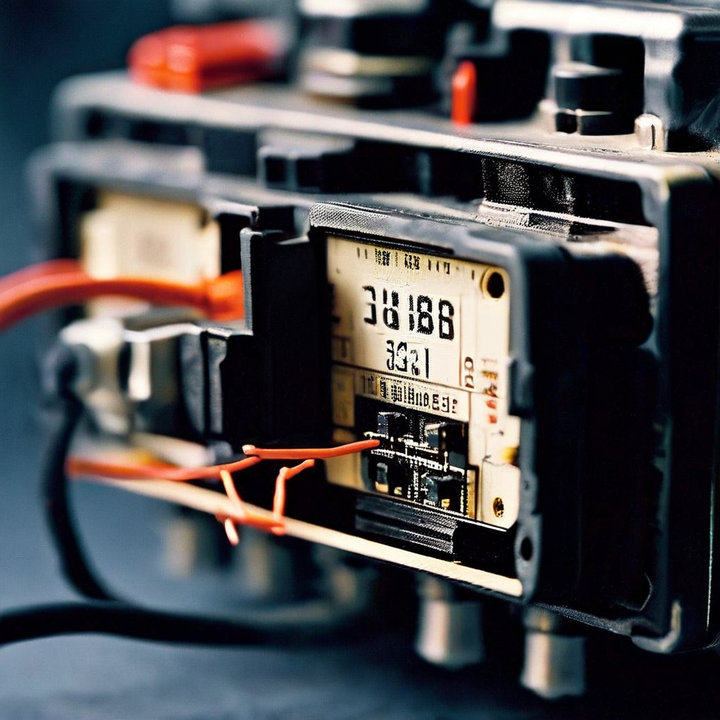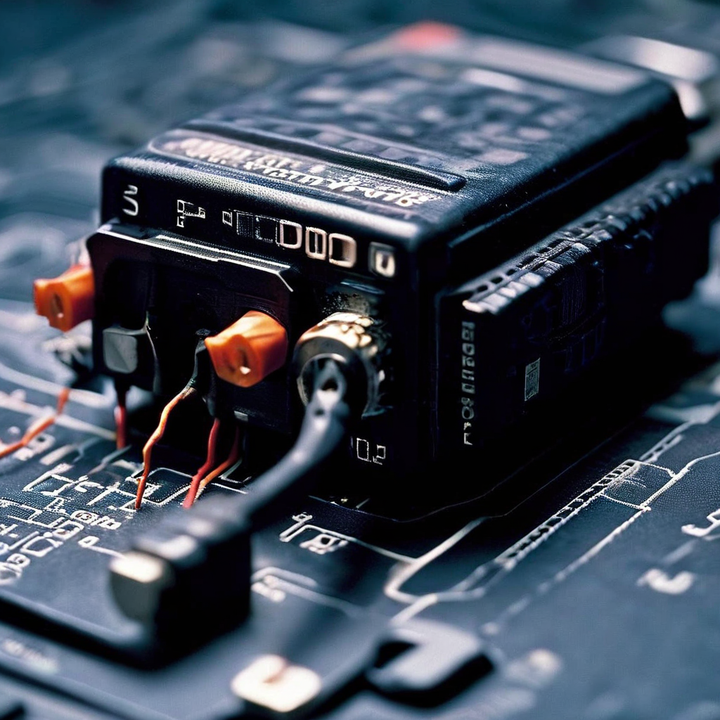


The diagnostic trouble code (DTC) P03B6 indicates an issue with the cylinder 4 pressure sensor circuit in the engine. Specifically, it means that the sensor or its circuit is detecting an abnormally high voltage signal.
Before we dive into the causes and solutions, let's take a moment to appreciate the unsung hero of our story: the pressure sensor. This little guy plays a crucial role in monitoring the combustion pressure within each cylinder, providing vital information to the engine control module (ECM) for optimal performance and efficiency.
| Sensor Function | Description |
|---|---|
| Pressure Monitoring | Keeps a watchful eye on the explosive dance of air and fuel inside the cylinders |
| Data Transmission | Sends accurate pressure readings to the ECM for precise adjustments |
| Engine Optimization | Enables smooth and reliable engine operation by providing real-time data |
Without its accurate readings, the ECM would be flying blind, unable to make the necessary adjustments for optimal engine performance. Think of it like a tiny spy, keeping a watchful eye on the explosive dance of air and fuel inside the cylinders.
Now, let's get down to business and explore the main culprits behind the P03B6 code. Brace yourselves, because there are a few usual suspects that could be causing this mischief:
Just like any other component, pressure sensors can succumb to wear and tear over time. Here are some common reasons why a pressure sensor might go rogue:
| Cause | Description |
|---|---|
| Contamination | Exposure to dirt, debris, or other contaminants can affect sensor accuracy |
| Physical Damage | Impact, vibration, or improper handling can damage the sensor |
| End of Service Life | Like all components, sensors have a finite lifespan and can fail due to age |
When a pressure sensor goes rogue, it can send erratic or inaccurate readings to the ECM, triggering the dreaded P03B6 code.
Ah, the age-old nemesis of every mechanic: wiring issues. A short to ground, an open circuit, or even a damaged wire can wreak havoc on the pressure sensor circuit, causing the ECM to see a high voltage reading where there shouldn't be one.
Short to Ground: A short circuit can cause a high voltage reading by allowing current to flow through an unintended path.
Open Circuit: A break in the wiring can prevent the signal from reaching the ECM, resulting in a high voltage reading.
Damaged Wiring: Chafed, pinched, or cut wires can disrupt the signal and cause erratic readings.
It's like trying to communicate with someone through a faulty telephone line – the message just doesn't get through correctly.
Last but not least, we have the connector gremlins. A loose or corroded electrical connector, either at the pressure sensor or the ECM, can create intermittent high voltage readings.
Loose Connector: A loose connection can cause intermittent signal loss or high voltage readings.
Corroded Connector: Corrosion on the connector pins can interfere with the electrical signal, leading to erratic readings.
It's like having a bad connection on your headphones – one minute you're jamming to your favorite tunes, and the next, you're met with static and silence.
Now that we know the potential troublemakers, it's time to put on our detective hats and start sleuthing. Here's how we can go about diagnosing the root cause of the P03B6 code:
First things first, we need to see if our suspect has any accomplices. By checking for other stored trouble codes related to the pressure sensors, we can gain valuable insights and potentially pinpoint the root cause more efficiently.
Check for codes related to other pressure sensors or the engine control module (ECM).
Multiple codes can help narrow down the issue to a specific component or system.
Next up, we'll conduct a good old-fashioned visual inspection. We'll scrutinize the wiring and connectors for the cylinder 4 pressure sensor, looking for any signs of damage, corrosion, or loose connections.
Inspect the wiring harness for any chafing, cuts, or pinched wires.
Check the connectors for signs of corrosion, bent pins, or loose connections.
Look for any signs of physical damage to the pressure sensor itself.
It's like searching for clues at a crime scene – every detail counts.
With our trusty scanner in hand, we'll dive into the live data for the cylinder 4 pressure sensor reading. If we see an erratic, stuck, or out-of-range reading, we can confidently point our finger at a faulty sensor as the culprit.
| Live Data Observation | Potential Cause |
|---|---|
| Erratic Reading | Faulty sensor or intermittent wiring issue |
| Stuck Reading | Sensor failure or wiring short to ground |
| Out-of-Range Reading | Sensor failure or wiring open circuit |
For those who love a good technical challenge, we'll break out the multimeter and perform resistance tests on the pressure sensor circuit. By following the vehicle repair manual's instructions, we can check for shorts or open circuits, further narrowing down the potential causes.
Measure the resistance across the sensor circuit with the sensor disconnected.
Compare the resistance values to the specifications in the repair manual.
Look for any deviations that could indicate a short or open circuit.
Once we've cracked the case and identified the root cause, it's time to roll up our sleeves and get to work. Here's what we can do to fix the issue and prevent it from happening again:
If the pressure sensor itself is the guilty party, we'll replace it with a shiny new one. But fear not, we'll follow the proper procedure to remove and reinstall the sensor, ensuring a seamless transition for our engine's spy network.
Follow the manufacturer's instructions for sensor removal and installation.
Ensure all connections are clean and secure before reinstalling the new sensor.
Update the sensor calibration or perform any required relearning procedures.
In the case of wiring woes, we'll channel our inner electricians and repair or replace any damaged wiring and connectors.
Locate and repair any chafed, pinched, or cut wires.
Replace any corroded or damaged connectors.
Ensure all connections are properly crimped and sealed.
We'll make sure those electrical signals can flow freely, without any interference or interruptions.
For those pesky connector gremlins, we'll give them a good cleaning and ensure all electrical connections are tight, clean, and properly seated.
Use a wire brush or electrical contact cleaner to remove any corrosion or debris.
Inspect the connector pins for any damage or bending, and repair or replace as needed.
Ensure all connectors are fully seated and locked in place.
No more intermittent high voltage readings on our watch!
After our repairs are complete, we'll clear the codes and take our trusty steed out for a test drive. This final step ensures that our hard work has paid off and that the P03B6 code is nothing but a distant memory.
Use a diagnostic scanner to clear any stored trouble codes.
Take the vehicle for a comprehensive test drive, monitoring for any recurrence of the issue.
Verify that the live data for the cylinder 4 pressure sensor is within the expected range.
To keep the P03B6 code at bay, we'll follow the manufacturer's recommended service intervals for replacing pressure sensors. Regular inspections of electrical connectors during routine maintenance can also help us catch any potential issues before they become major problems.
| Preventive Measure | Description |
|---|---|
| Sensor Replacement | Follow the recommended replacement intervals for pressure sensors |
| Connector Inspection | Inspect electrical connectors during routine maintenance for signs of damage or corrosion |
| Avoid Contamination | Minimize exposure to excessive soot buildup or contamination that can foul the sensors |
Additionally, we'll do our best to avoid exposing the engine to excessive soot buildup or contamination, as these can foul the sensors and lead to premature failure.
Now, let's address the elephant in the room: the cost. The truth is, the cost can vary depending on the root cause and the specific vehicle model. However, here's a general breakdown to give you an idea:
| Repair Item | Typical Cost Range |
|---|---|
| Replacement Pressure Sensor | $100 - $300 |
| Wiring Repair (if extensive) | $200 - $500 |
| Labor Costs | 1 - 3 hours of labor |
Remember, proper diagnosis is crucial to avoid unnecessary part replacements and save you from breaking the bank.
Well, folks, that's a wrap on our deep dive into the P03B6 code! We've explored the causes, diagnostic steps, repair instructions, and preventive measures to keep your engine running smoothly. Remember, a little knowledge and preventive maintenance can go a long way in avoiding costly repairs down the road.
So, the next time you encounter this pesky code, you'll be armed with the knowledge and confidence to tackle it head-on. Trust me, your engine (and your wallet) will thank you!
Cylinder pressure sensors monitor the combustion pressure within each cylinder and provide vital information to the engine control module for optimal performance and efficiency. They enable smooth and reliable engine operation by providing real-time data.
The common causes include contamination, physical damage, and reaching the end of its service life.
A short to ground in the sensor wiring can cause a high voltage reading, while an open circuit or damaged wiring can disrupt the signal and trigger this code.
A loose or corroded electrical connector at the pressure sensor or engine control module can create intermittent high voltage readings, leading to the P03B6 code.
Check for other related trouble codes, visually inspect the wiring and connectors, analyze live data readings, and perform resistance tests on the pressure sensor circuit.
Replace the faulty pressure sensor with a new one, following the proper procedure to remove and reinstall it.
Follow the manufacturer's recommended service intervals for replacing pressure sensors and inspect electrical connectors during routine maintenance.
The cost can vary, but typically a replacement pressure sensor costs $100 - $300, wiring repair (if extensive) can cost $200 - $500, plus labor costs.
Use a diagnostic scanner to clear any stored trouble codes, and then take the vehicle for a comprehensive test drive to verify the fix.
Proper diagnosis is crucial to avoid unnecessary part replacements and save costs.

Miguel started tinkering with car radios as a teenager, fascinated by the intricate dance of wires and circuits. This passion led him to pursue a career as an automotive electrician. For the past 10 years, Miguel has tackled everything from flickering headlights to mysterious electrical gremlins. He thrives on troubleshooting electrical problems and enjoys sharing his knowledge to empower car owners to understand their vehicles better.



